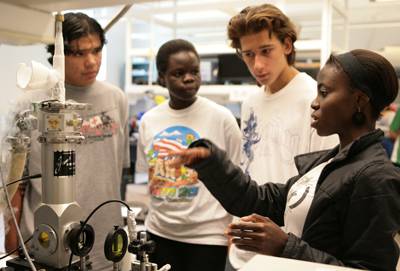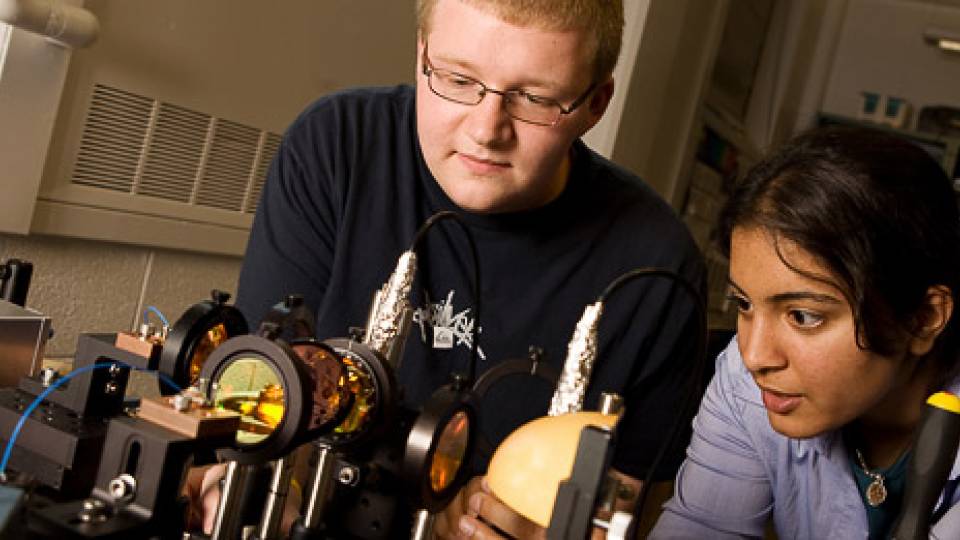A little clay and sawdust went a long way at Princeton this month when a group of Trenton-area high school students used the simple materials to create effective, low-cost water filters.
The project was part of the Princeton University Materials Academy outreach program for underrepresented minorities and low-income students, many of whom are in the federally funded Upward Bound and GEAR UP educational programs directed locally at the James Kerney Campus of Mercer County Community College in Trenton. Now in its sixth year, the academy is offered each summer by the Princeton Center for Complex Materials.
"The Princeton University Materials Academy is a way to reach a number of students who wouldn't otherwise have a lot of exposure to science and technology," said the center's director Richard Register, a professor of chemical engineering. "We want to open their eyes to the possibilities available to them at Princeton and beyond. Ultimately, we'd like to broaden our reach beyond the 30 students we work with each year by disseminating the experiments and activities on the Web."
The program introduces students to materials science concepts in modules developed at Princeton around real-world science and engineering challenges. Previous programs have addressed cancer detection and the development of solar-powered ovens. This year's academy focused on the design of low-cost, sustainable water filters for use in the developing world. Currently, more than 1.5 million children under age 5 die each year from water-borne illnesses that could be prevented by effective filtration practices.

Mechanical and aerospace engineering professor Wole Soboyejo, the founder and director of the U.S./Africa Materials Institute, designed and advised the water filtration project. During the academy, Soboyejo met with the students to discuss their filter designs and the broader implications of their work.
"It's fascinating to watch the students realize how materials that everyone has could be really powerful in improving human health," said Katie Camille Friedman, a rising sophomore at Princeton who helped guide the students' investigations. Friedman is a member of the Global Development Network student group, supervised by Soboyejo, which promotes sustainable technologies in developing countries. As part of the materials academy, Friedman shared her experiences from a recent trip to Nicaragua working on water filtration with the Potters for Peace organization.
The materials academy students modeled their pot-shaped filters after one Friedman brought back from Nicaragua, fashioning them out of a mixture of clay and various organic materials, including sawdust, dried leaves and coffee grounds. When the filters were fired in a kiln, the organic material burned away and left behind tiny pores designed to trap bacteria but allow water to pass through. In a test using e. coli-contaminated water, the filters proved their ability to catch the e. coli while allowing water to flow through.
"This project could save lives," said James Sadley, a student in the Trenton Central High School Applied Engineering and Science Academy. "We're helping to find good ways to make better filters."
Nearby, his lab partner and classmate Brayan Palacios kept a close watch on their filter as he measured its flow rate. "They'll be cheaper, too," Palacios added, pointing out the need for a technology that not only works, but is affordable.
The students' engagement in the project and interdisciplinary understanding of technological problems are precisely what Daniel Steinberg, the PCCM director of education and outreach, is hoping to foster.
"The goal is to provide the students with an opportunity to study materials science and engineering that they wouldn't normally get in high school," he explained. "Because we focus on real-world problems, we're teaching the students complex engineering concepts and also helping prepare them for the future, on both on a personal and global level."
The work completed by the students in the materials academy, under the guidance of Middlesex High School and materials academy lead teacher Peter Gange, will contribute to ongoing efforts by the Global Development Network to explore economic and effective filtration technologies.

Following the two-week session on water purification, the students participated in a new weeklong program on laser technologies supported by the Mid-Infrared Technologies for Health and the Environment (MIRTHE) center. Sponsored by the National Science Foundation, the center unites researchers from six universities with partners in industry and government labs to develop sensors that detect trace amounts of chemicals in the atmosphere and human breath.
As part of the program, the students met with MIRTHE director Claire Gmachl, an associate professor of electrical engineering, and toured her lab where chemical-detecting lasers are being developed.
"This is high-tech, complex information," said Michael Ireland, the program's lead teacher. "So we're building on basic concepts they've been exposed to in school with experiments that excite the students and demonstrate how lasers can be used." Ireland, a high school teacher at the Perkiomen School in Pennsburg, Pa., spent the past two summers conducting research in the labs of the Princeton Center for Complex Materials as a participant in the center's Research Experience for Teachers program.
In one activity, Ireland had the students hook their iPods to laser pointers and shine the light down a hall to receivers connected to speakers. Many of the students were admittedly skeptical that anything would happen. But the laser light carried an encoded signal; music rang out loud and clear throughout Bowen Auditorium and so did the students' cries of astonishment and amazement.
Palacios summed it up. "That was really cool," he said with a grin.



